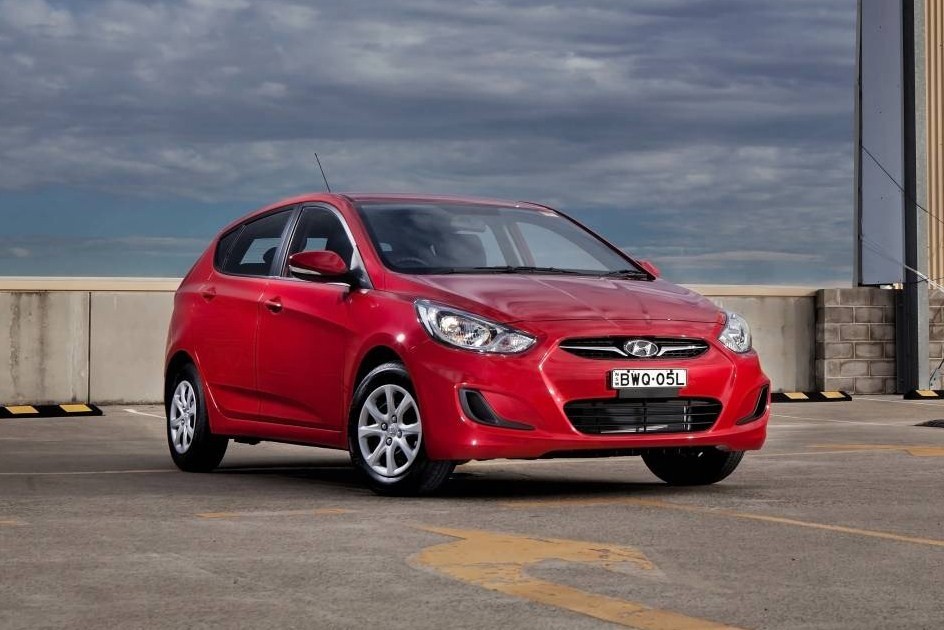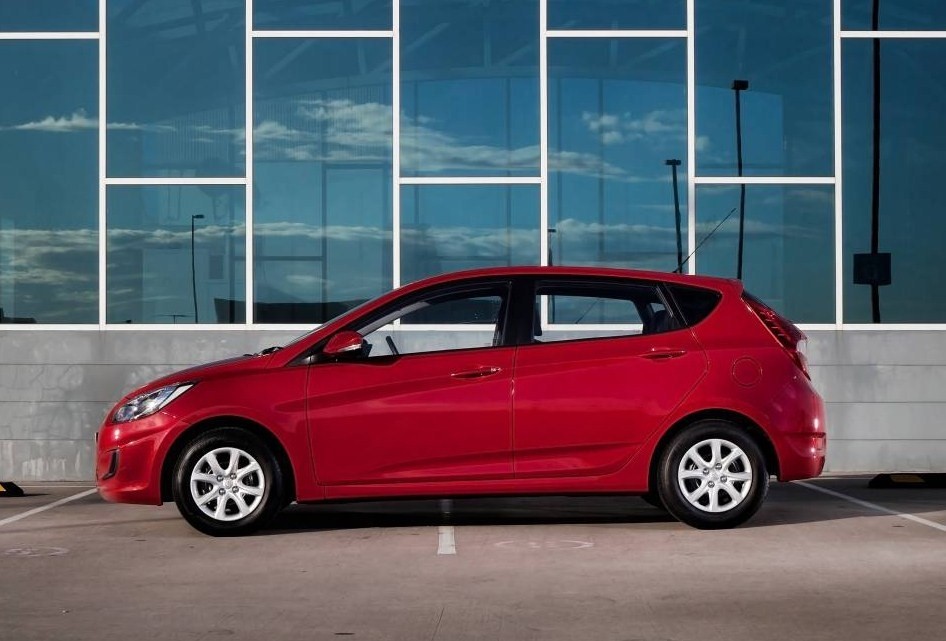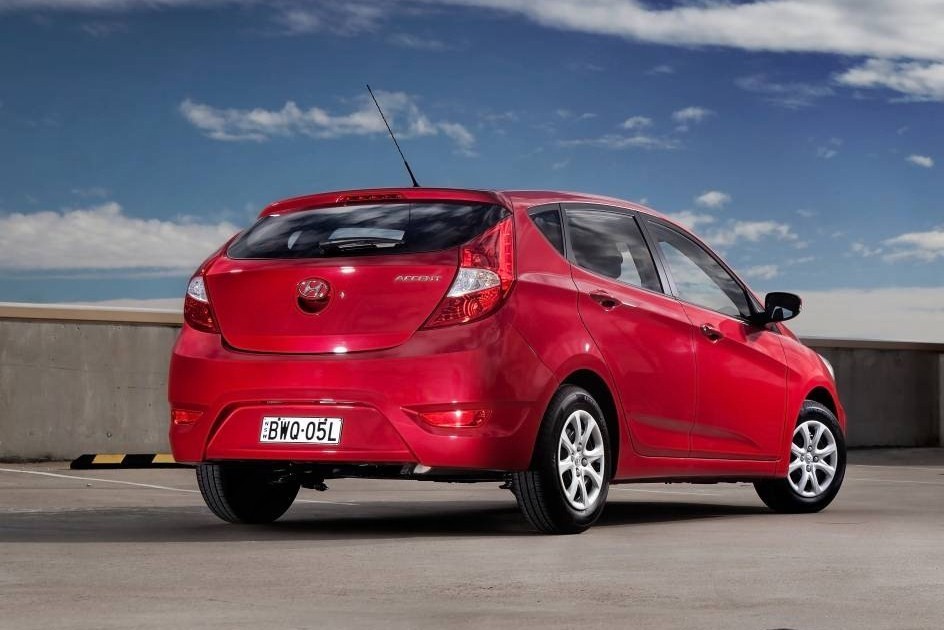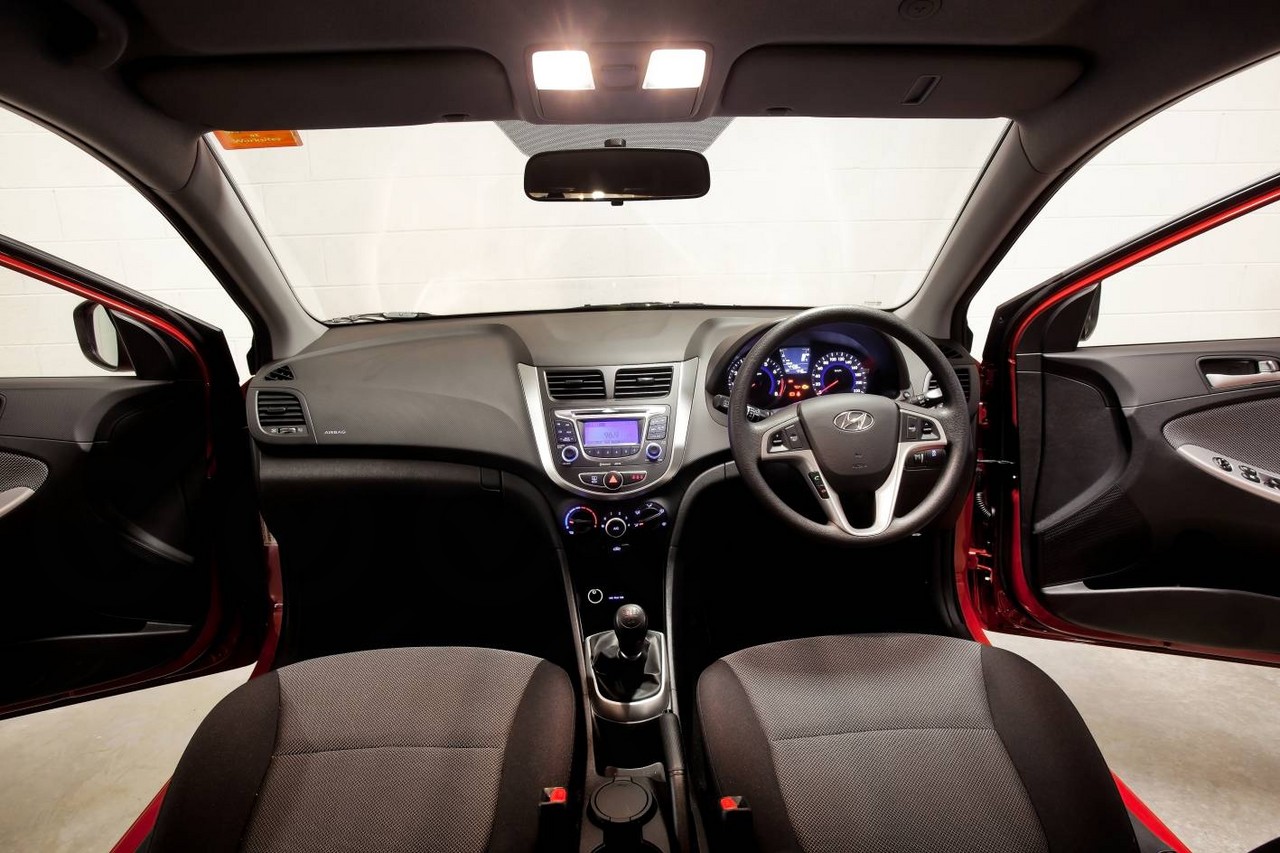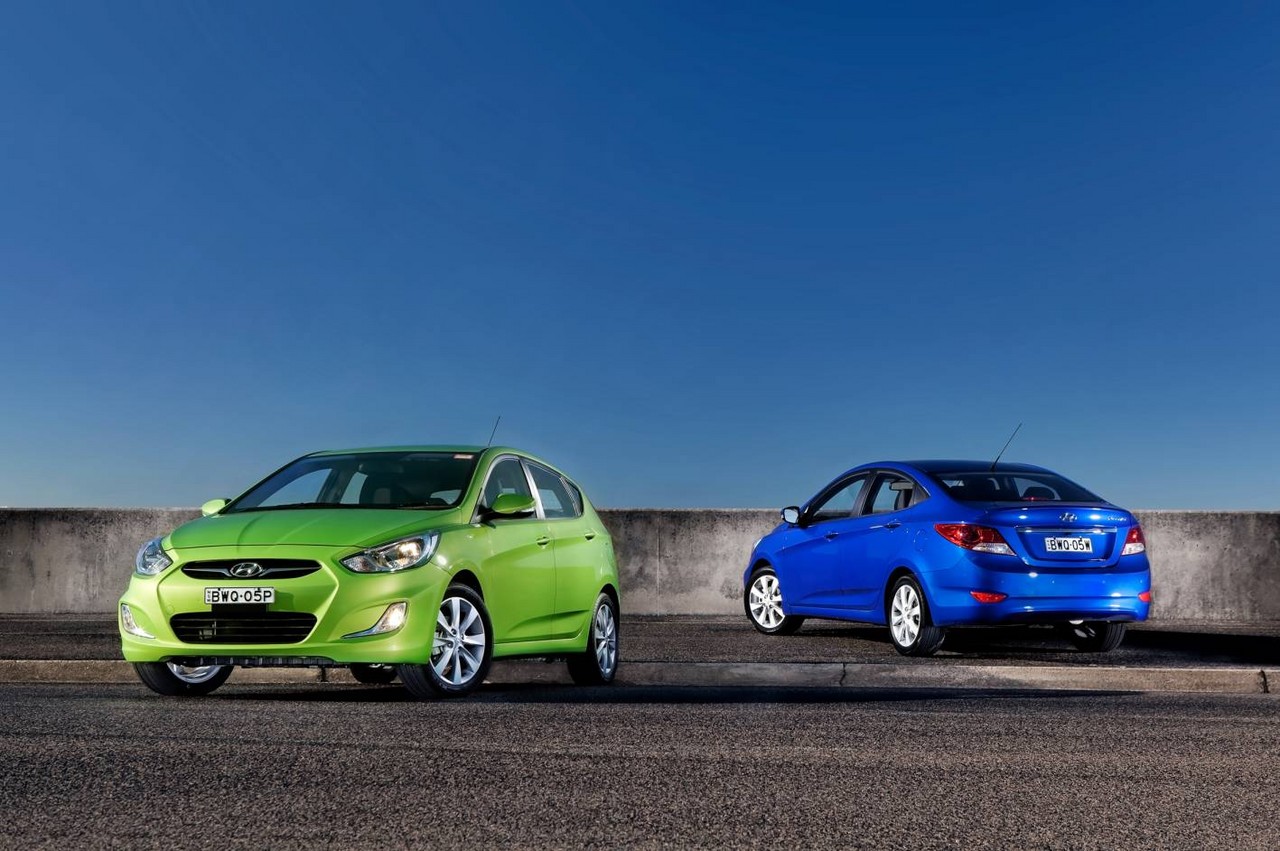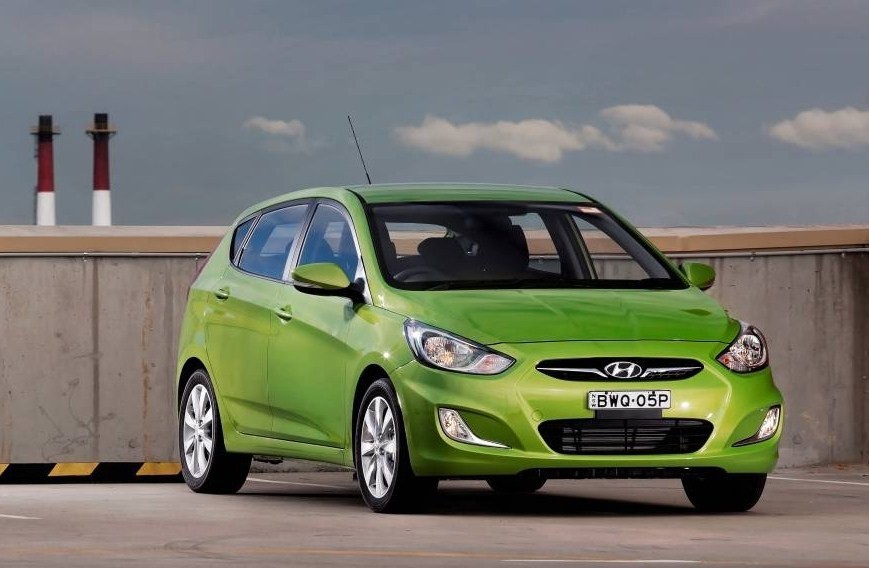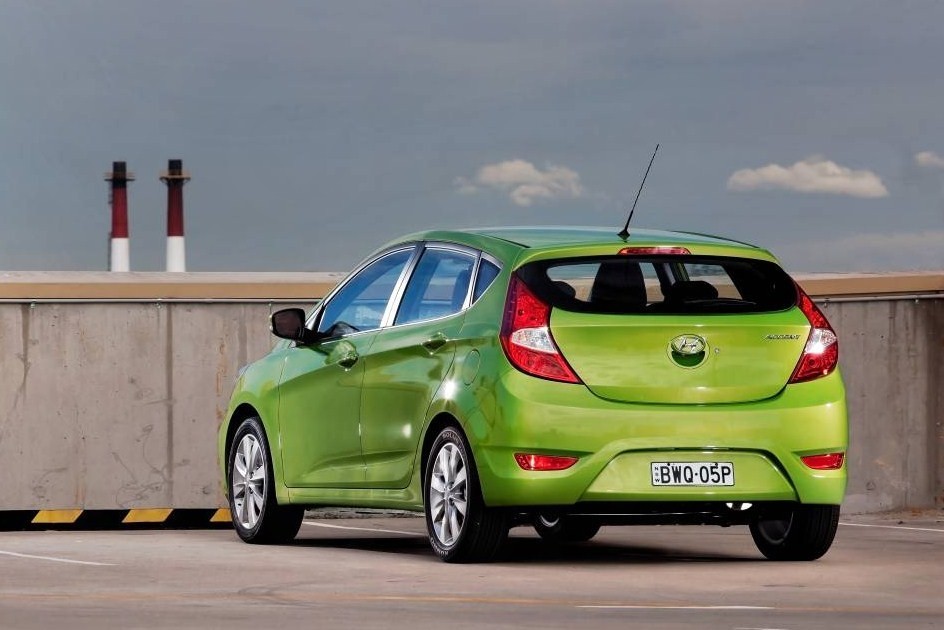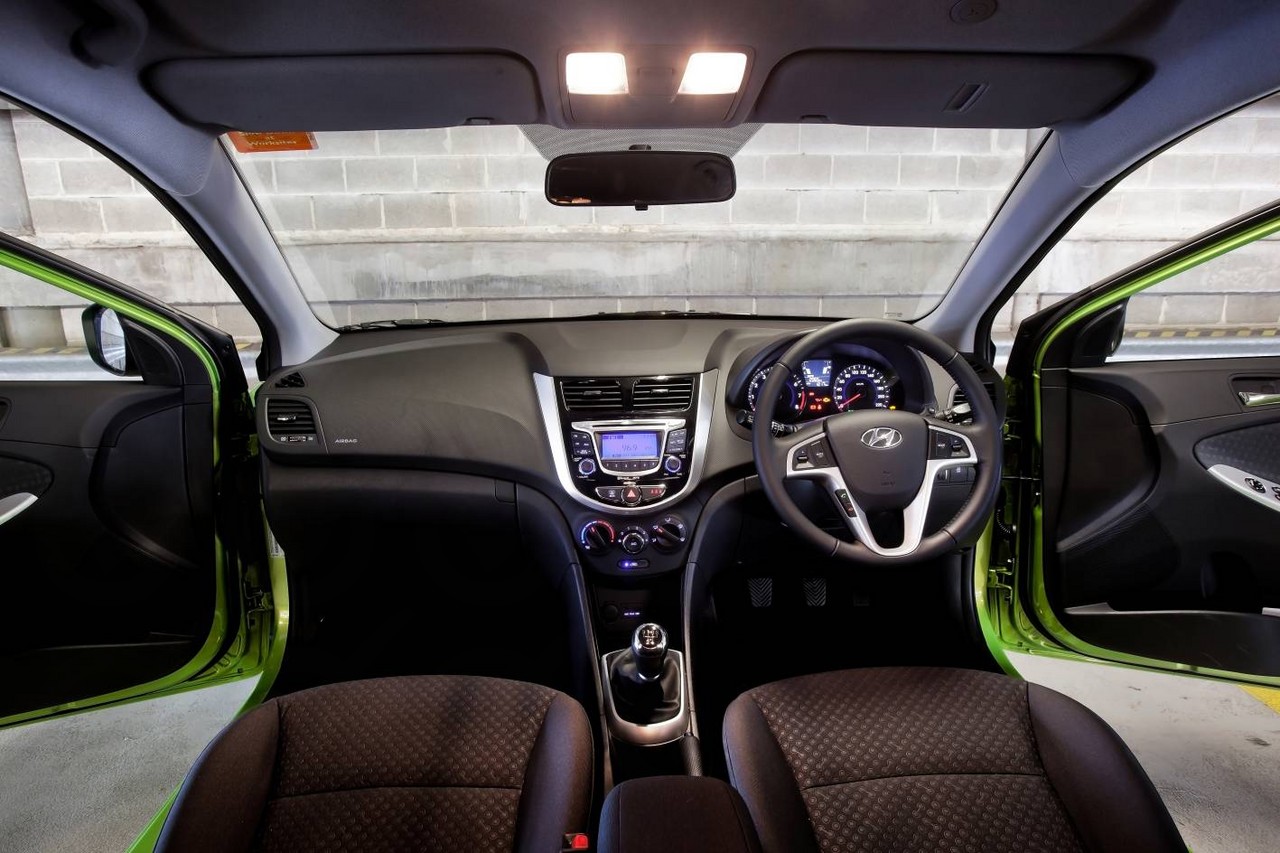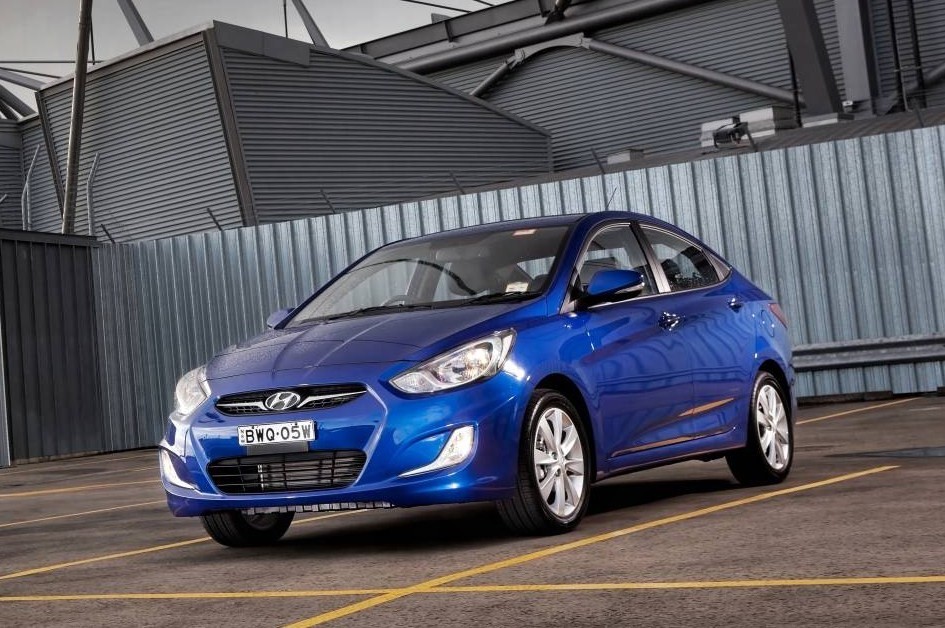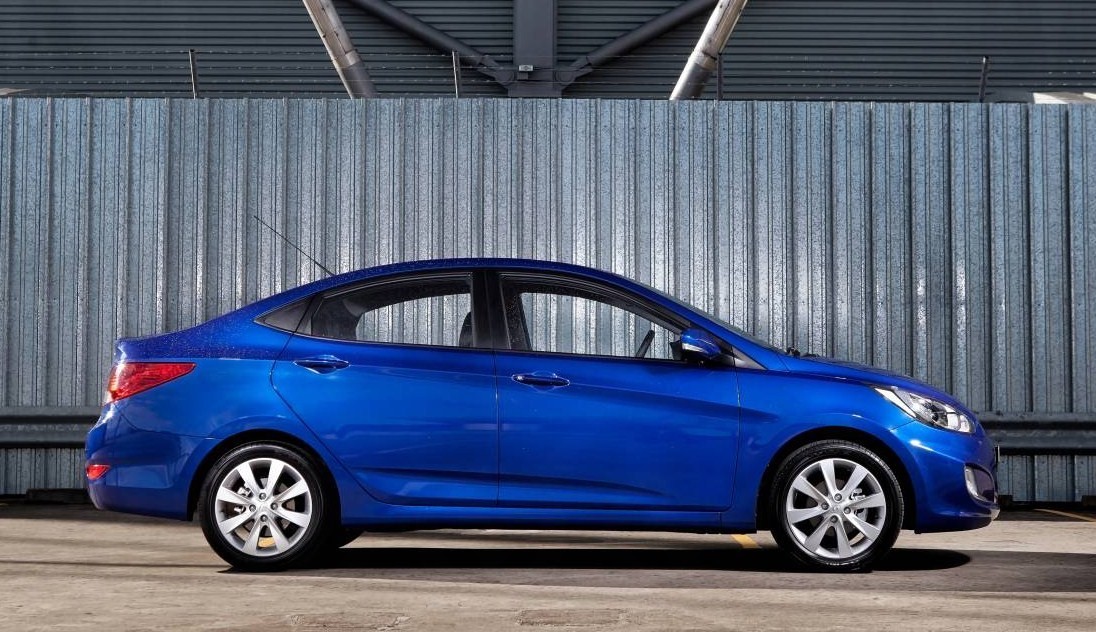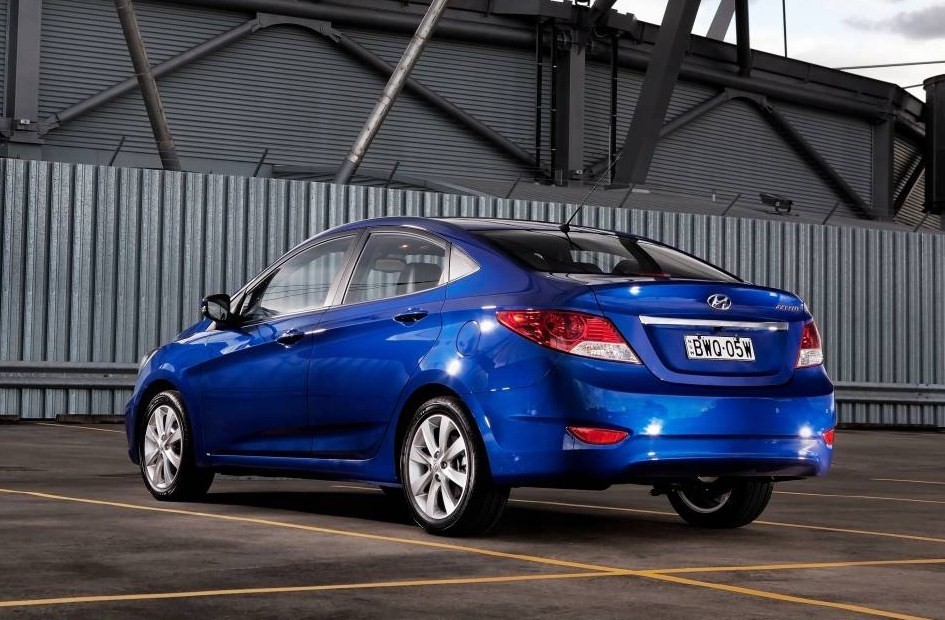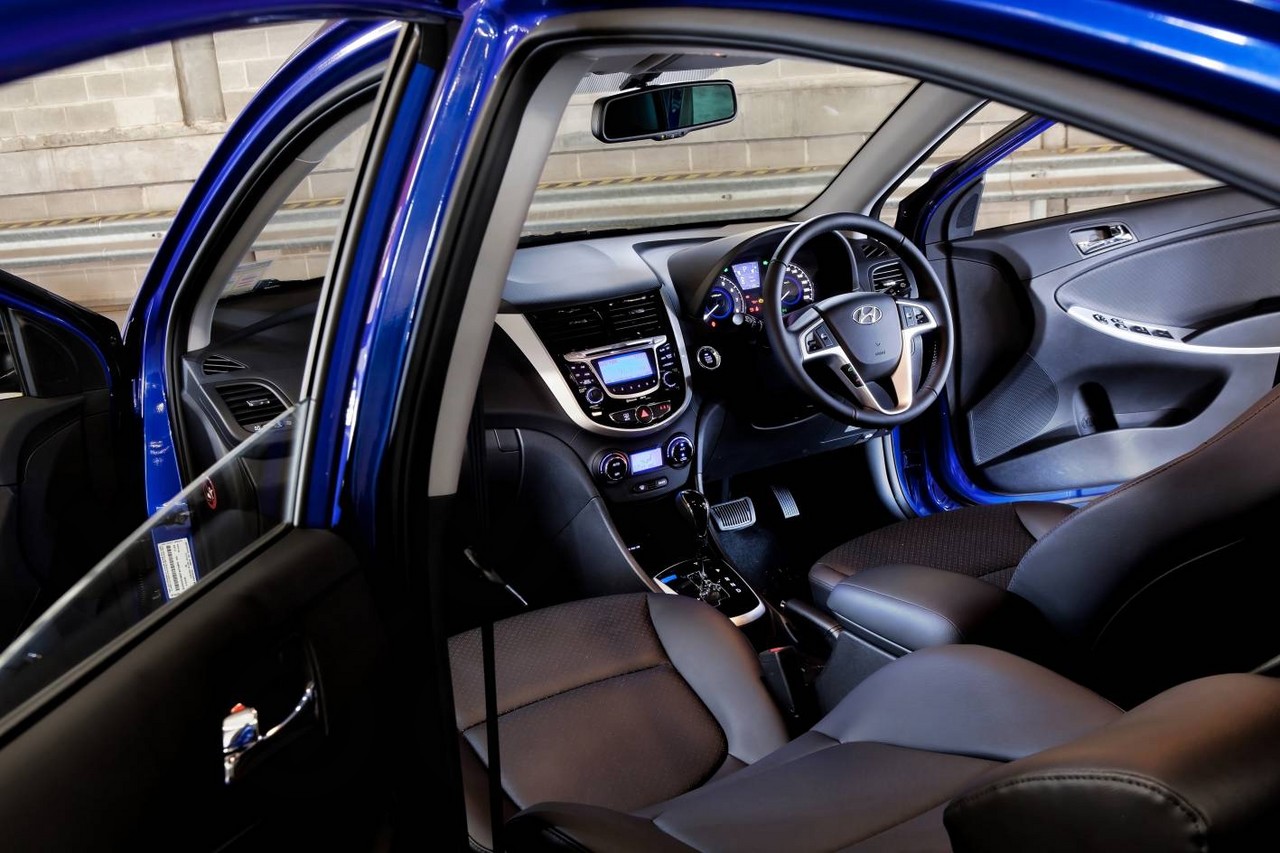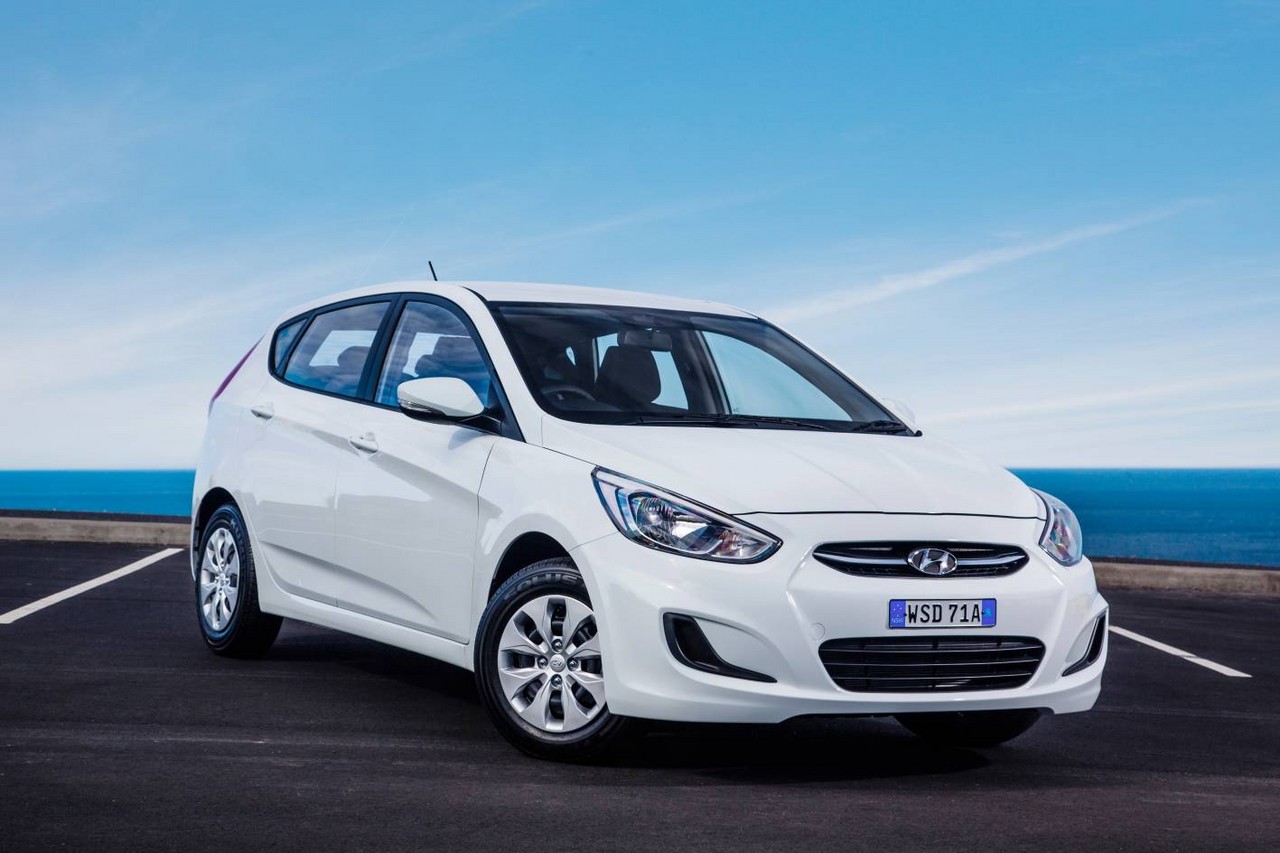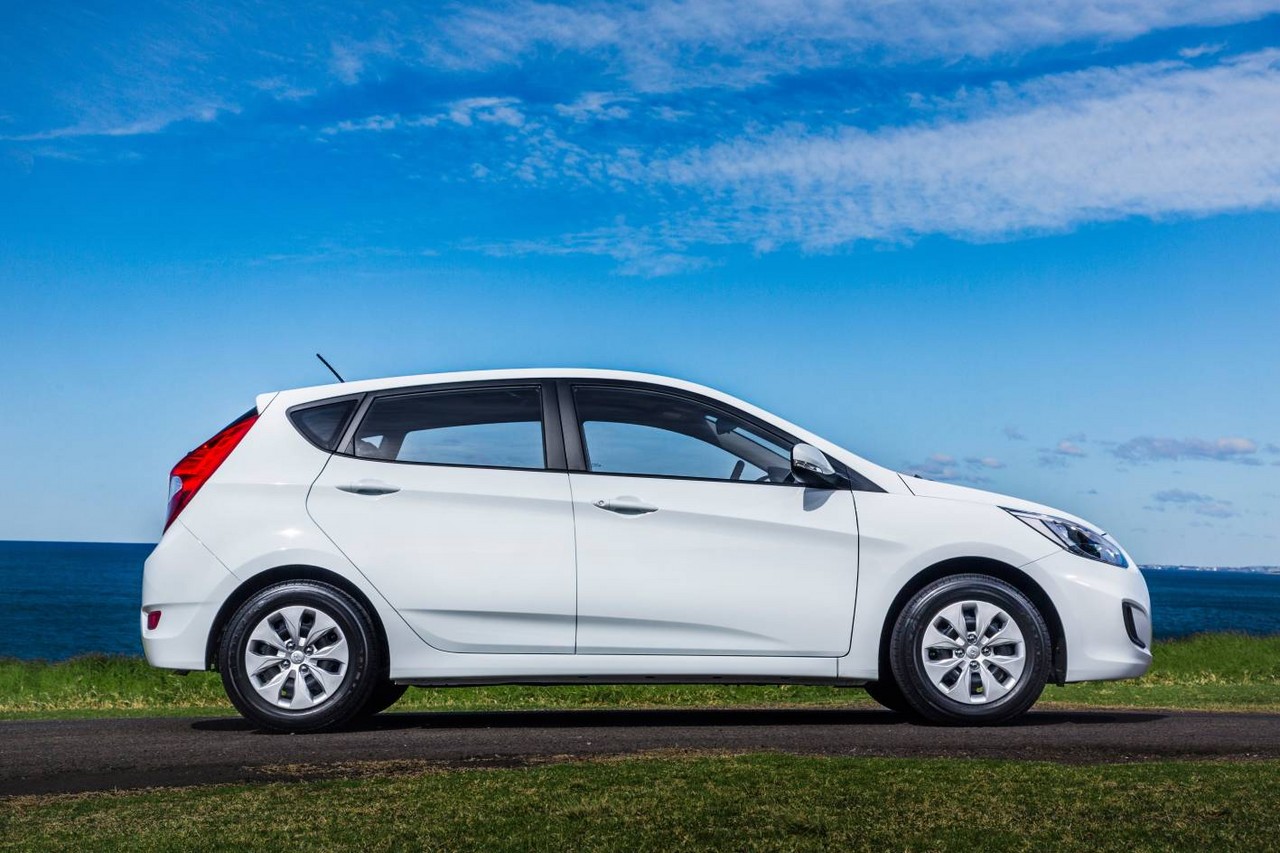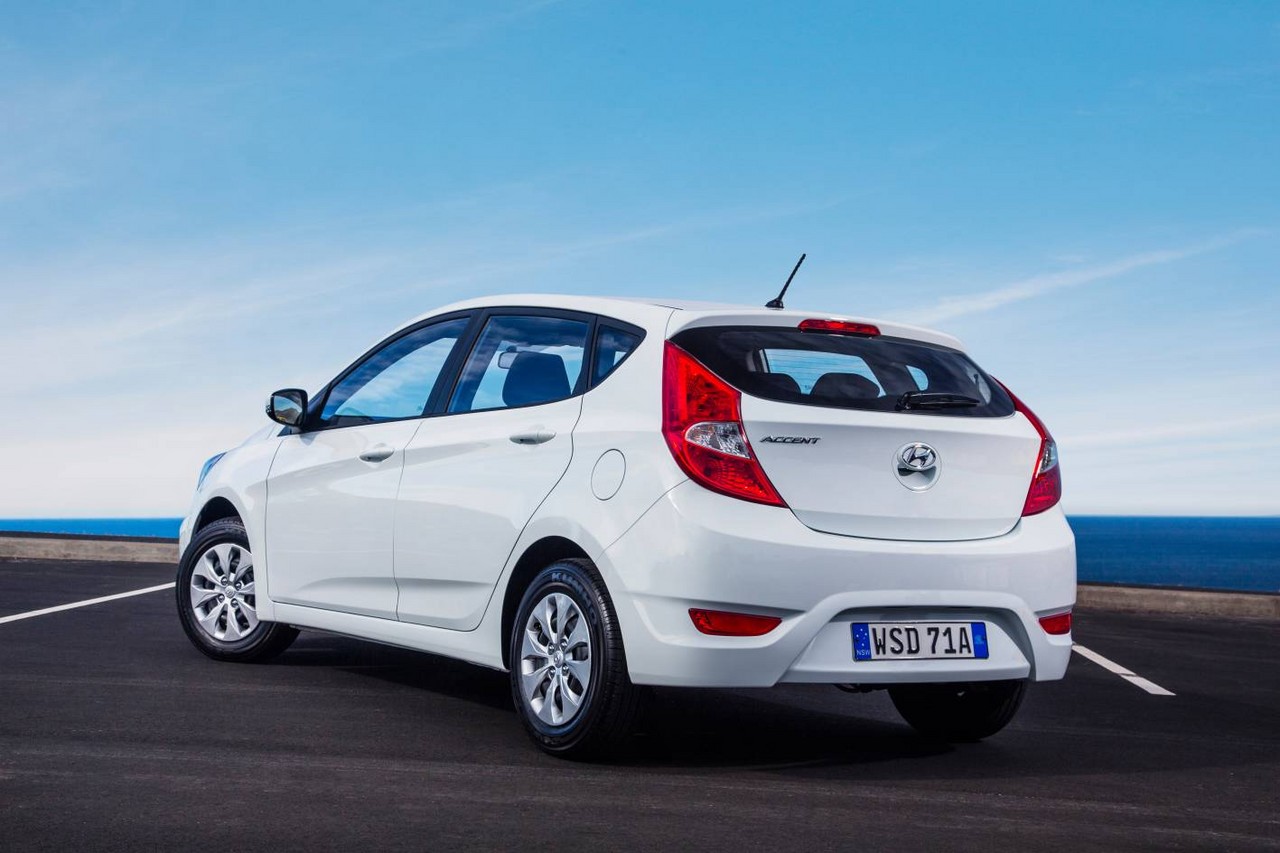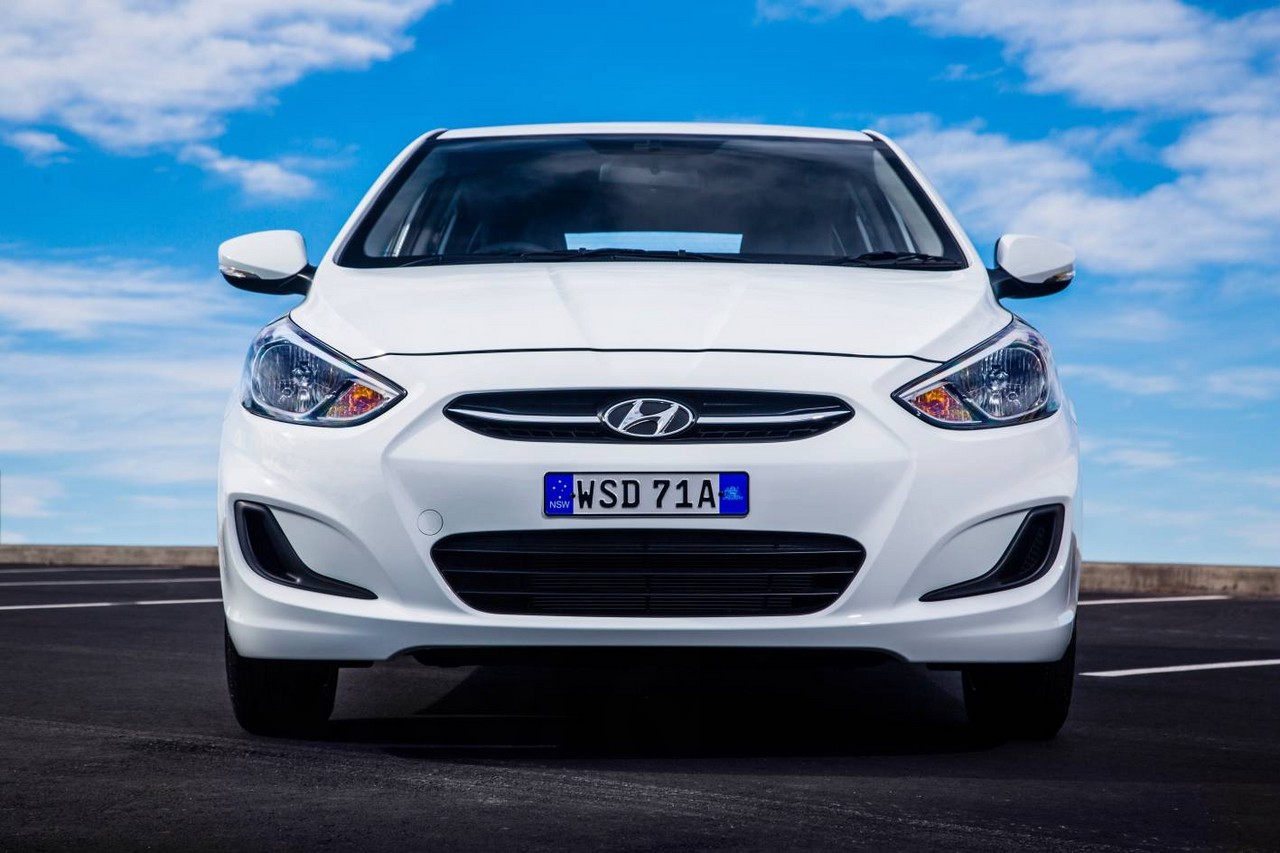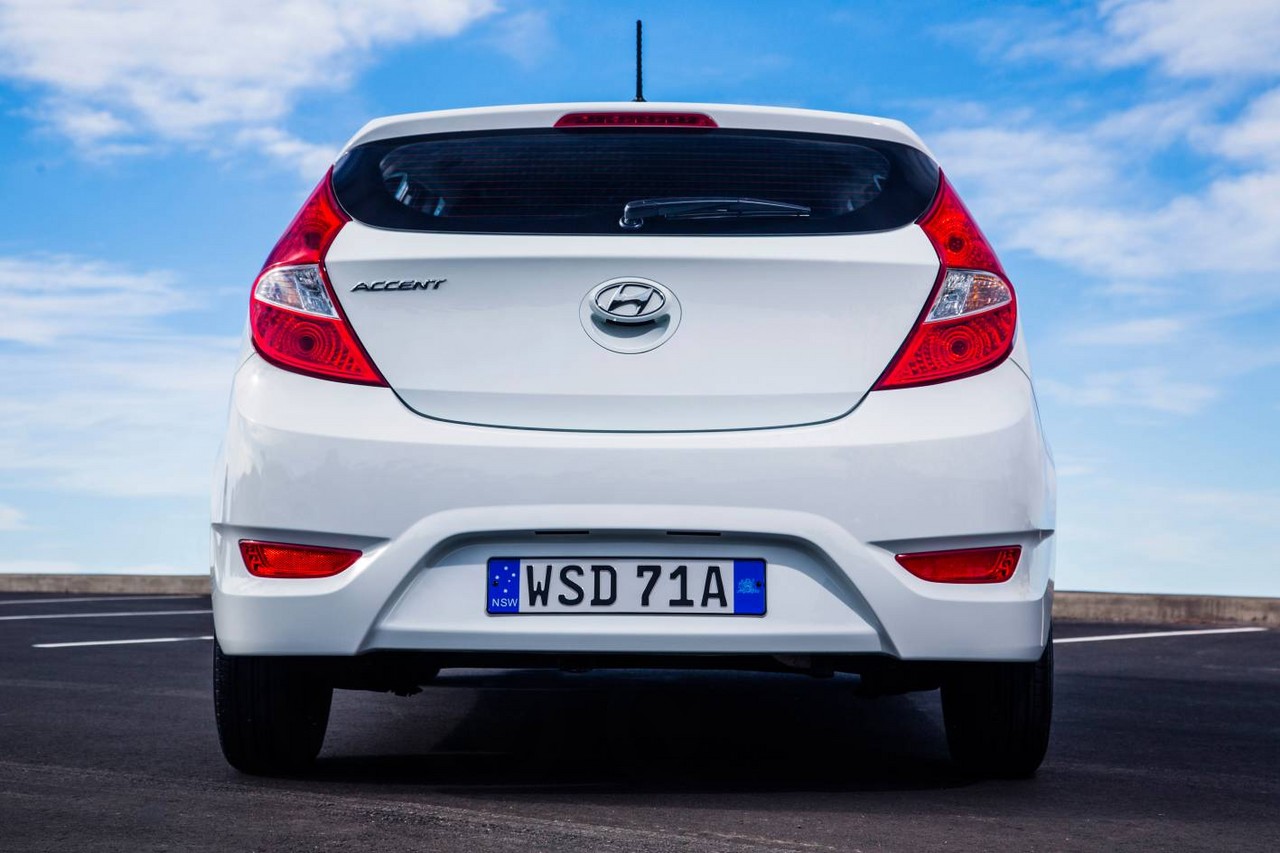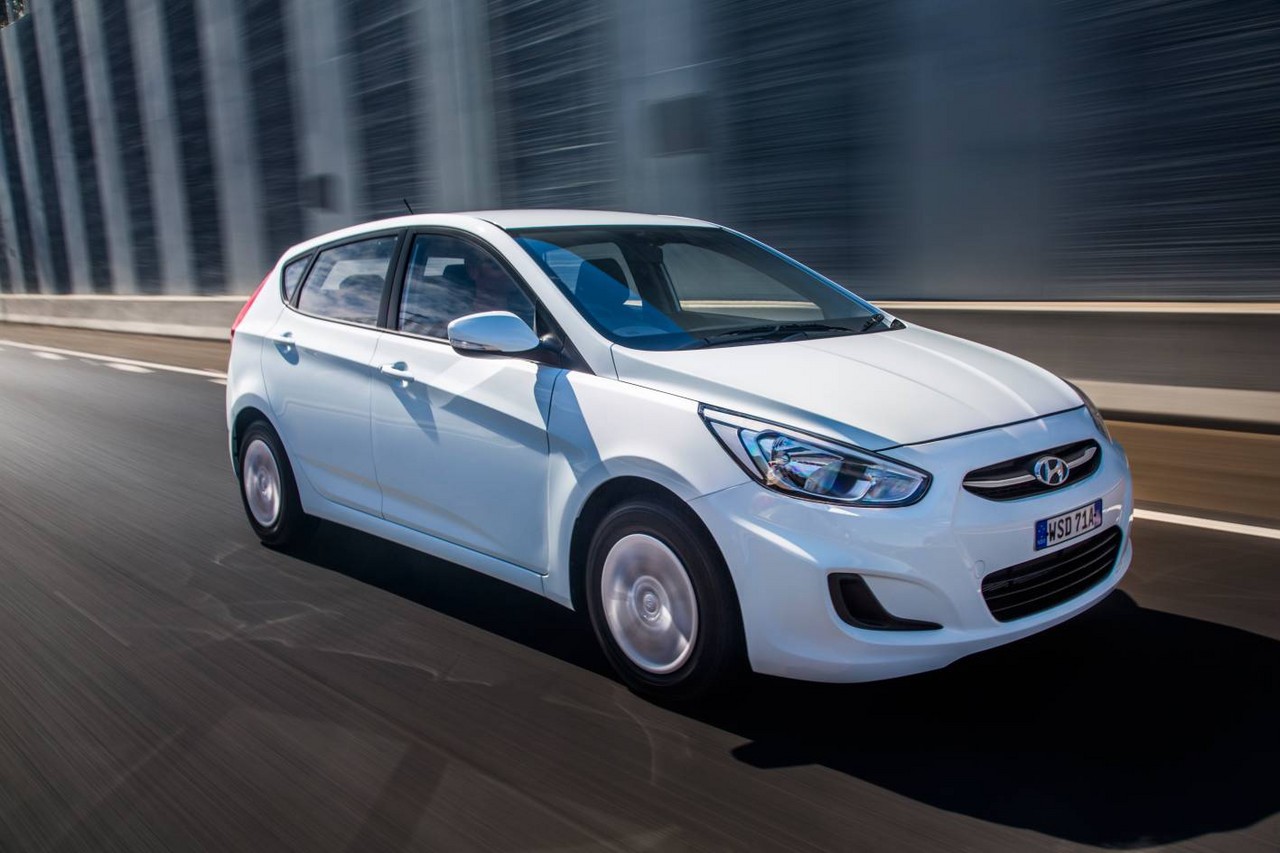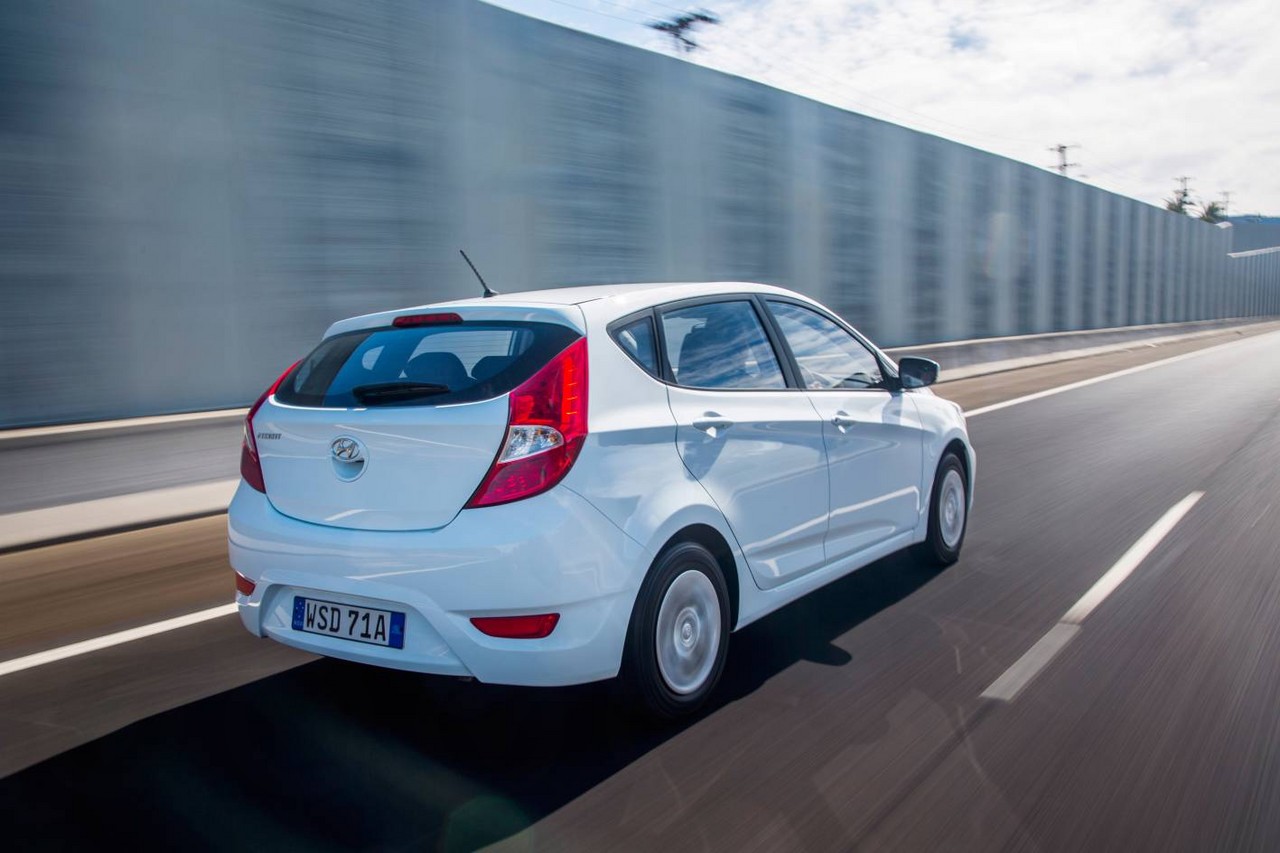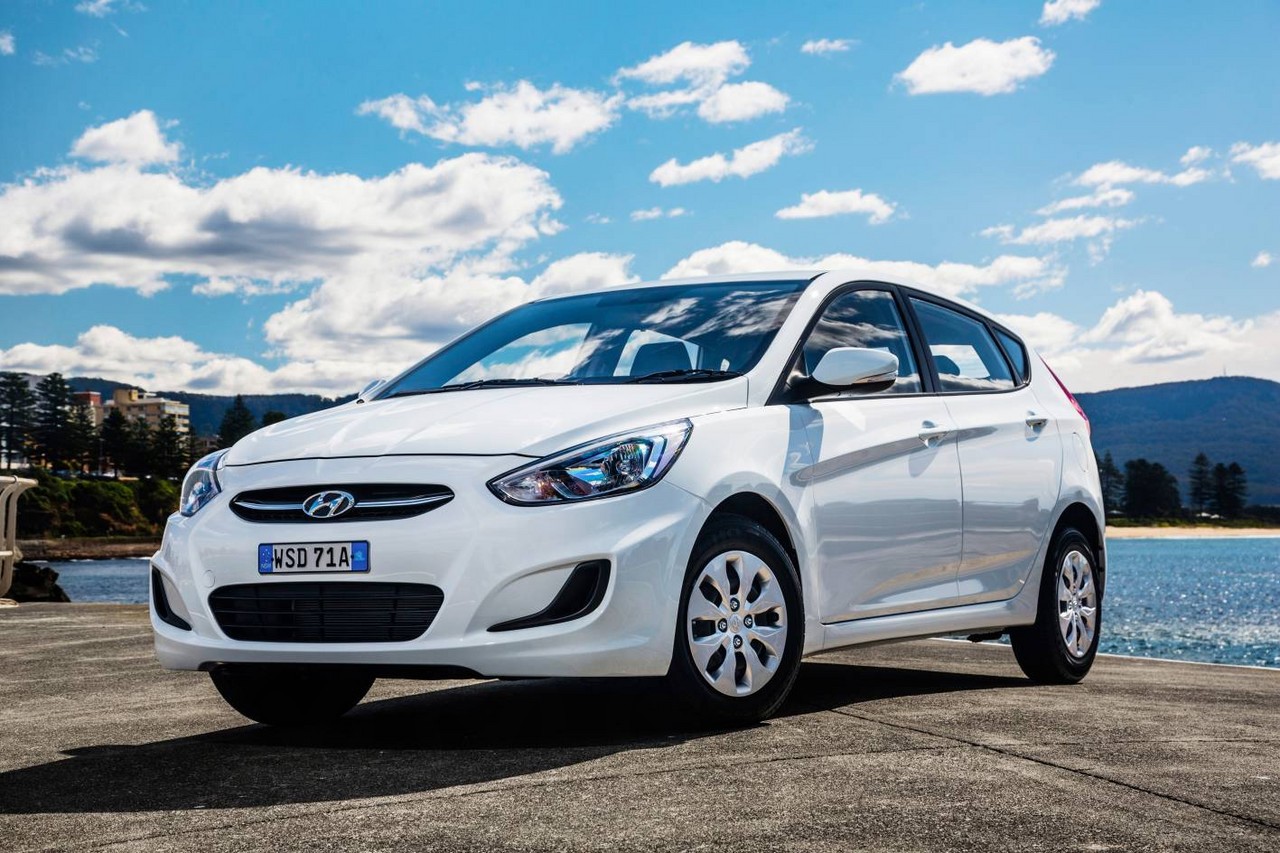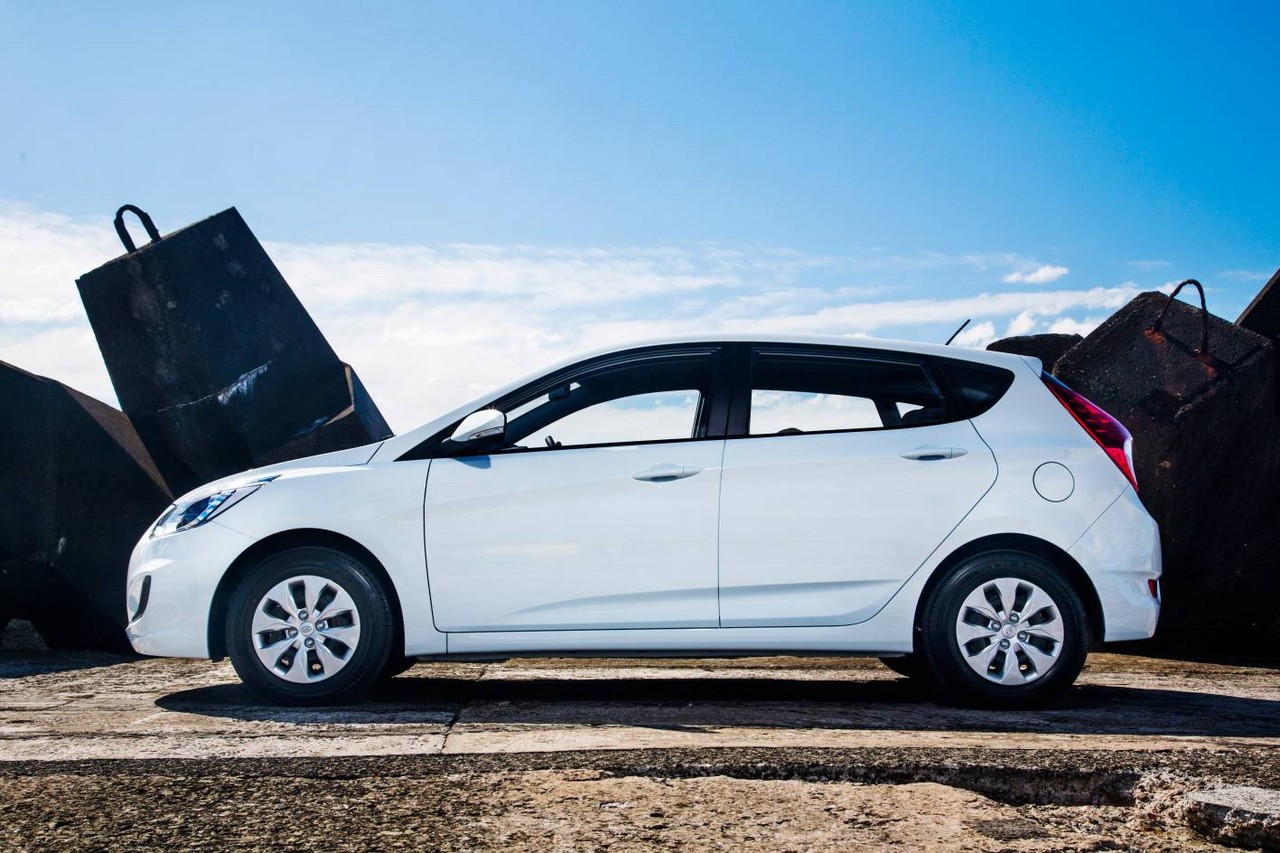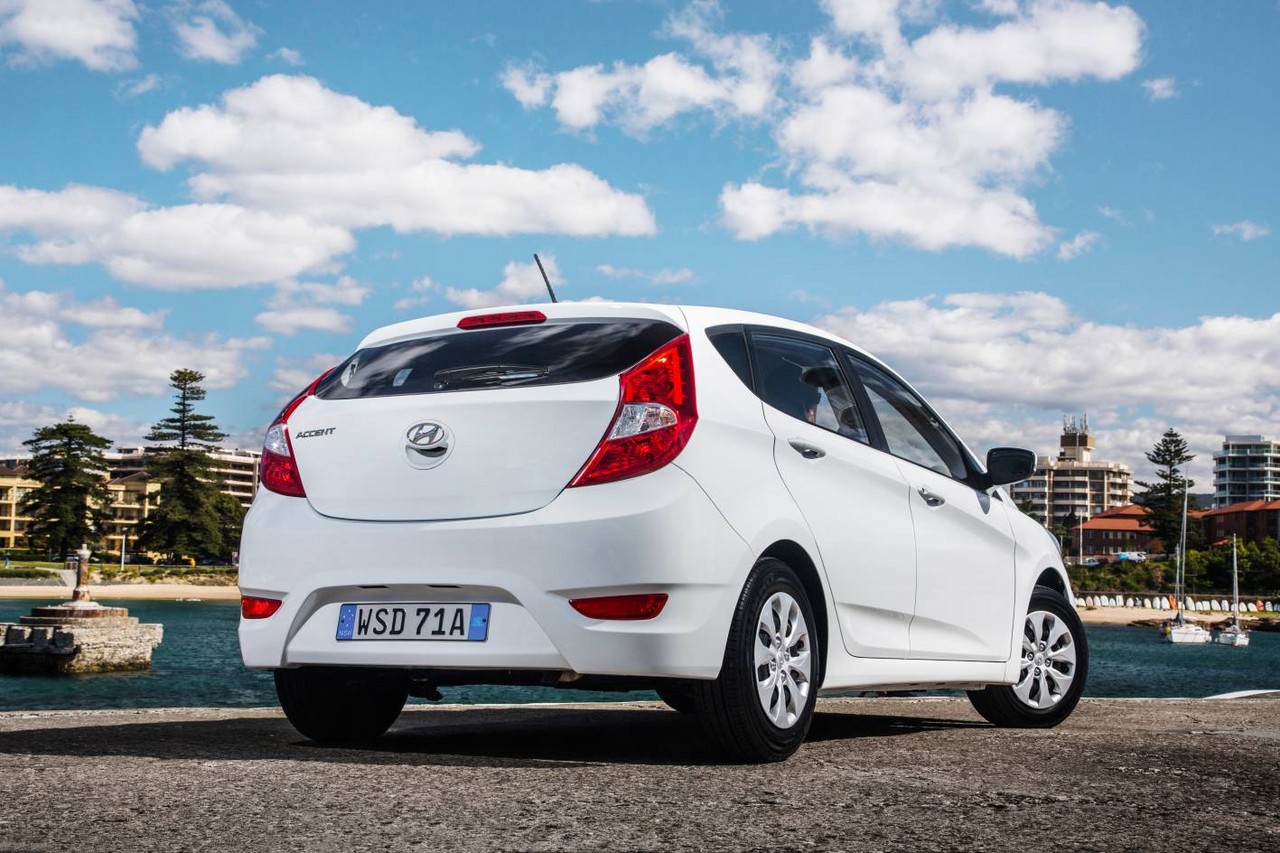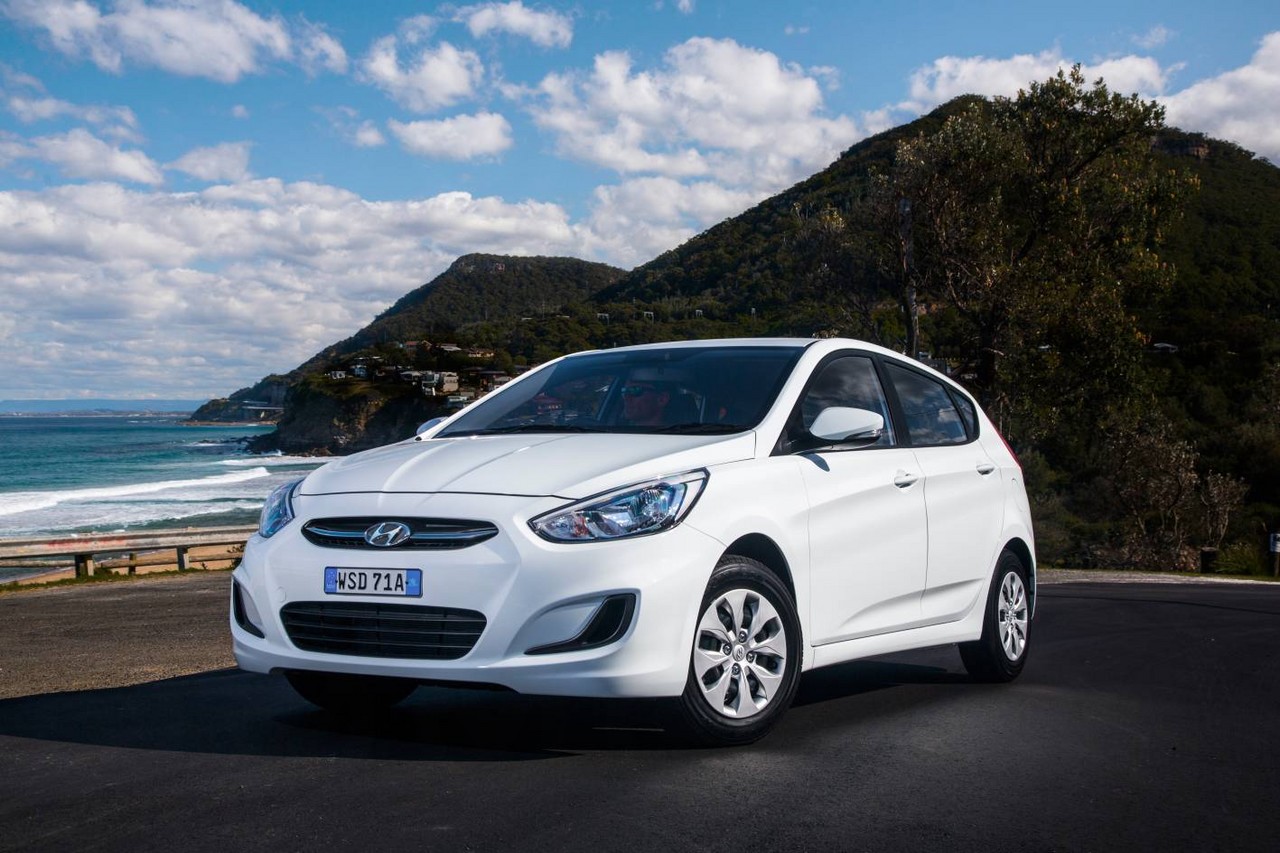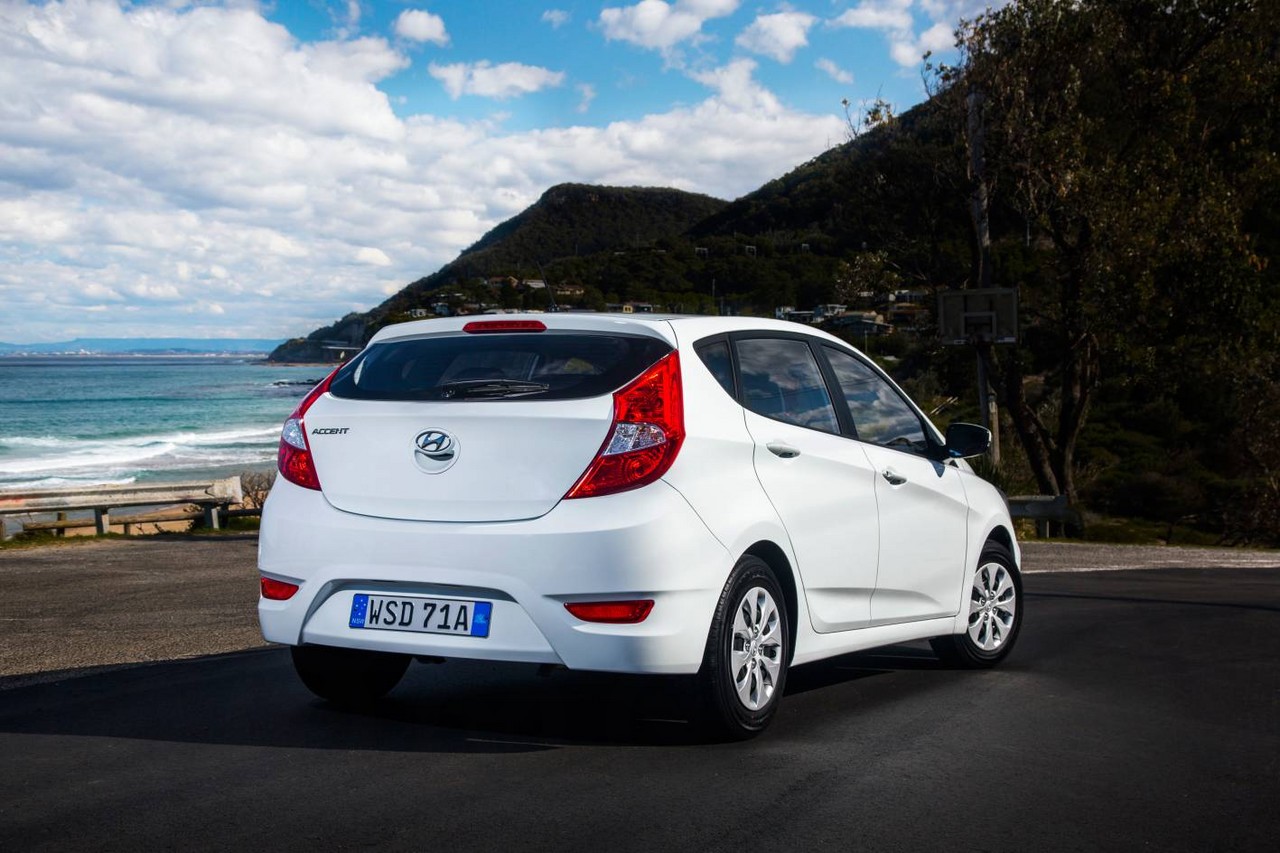
- Willing 1.6-litre petrol engines
- Frugal 1.6-litre turbo-diesel engine
- Good ride/handling balance
- Four-speed automatic transmission lacks ratios and flexibility of rivals
- Steering is inconsistently weighted and vague
- Long-travel clutch pedal doesn’t have clear friction point
Hyundai RB.I Accent (2011-15)
Overview
Released in August 2011, the Hyundai RB Series I (RB.I) Accent was available as a small five-door hatch or four-door sedan. Manufactured in Ulsan, South Korea, the RB Accent was initially offered with a 1.6-litre four-cylinder petrol engine. In January 2012, a 1.6-litre common-rail turbo-diesel engine was introduced and, in October 2013, a 1.6-litre petrol engine was introduced with direct injection. The Accent was available in Active, Elite and Premium variants, with SR variants available from October 2013.
G4FC, G4FD and D4FB engines
Of the engines,
- The 1.6-litre G4FC ‘Gamma II’ petrol engine had an aluminium block and head, double overhead camshafts, four valves per cylinder, continuously variable intake and exhaust valve timing (Hyundai’s dual CVVT) and a compression ratio of 10.5:1;
- The 1.6-litre G4FD petrol engine differed in that it had a direct injection and a higher compression ratio of 11.0:1; and,
- The 1.6-litre D4FB ‘U2’ turbo-diesel engine had a cast iron block, an aluminium cylinder head, common-rail direct injection, a variable geometry turbocharger, double overhead camshafts, four valves per cylinder and a compression ratio of 17.3:1.
Dimensions and body
Compared to its four-door MC Accent predecessor, the RB Accent sedan was 90 mm longer (at 4370 mm), 5 mm wider (1700 mm), 20 mm lower (1450 mm) and had a 70 mm longer wheelbase (2570 mm). Compared to the sedan, the RB Accent hatchback was 255 mm shorter (4115 mm), though its other measurements were the same. Furthermore, the increased use of high-strength steel contributed to a 22 per cent increase in body stiffness.
Suspension and steering
Like its predecessor, the RB Accent had MacPherson strut front and coupled torsion beam rear suspension. To minimise fuel consumption, the RB Accent was fitted with low-rolling resistance tyres and an electric power-assisted steering system.
| Body | Engine | Trans. | Variant | Years | Peak power | Peak torque |
|---|---|---|---|---|---|---|
| Hatch | 1.6-litre petrol I4 (G4FC) | 4sp auto, 5sp man. |
Active, Premium |
2011-15 | 91 kW at 6300 rpm | 156 Nm at 4200 rpm |
| Elite | 2011-13 | |||||
| 1.6-litre petrol I4 (G4FD) | 6sp man., 6sp auto |
SR | 2013-15 | 103 kW at 6300 rpm | 167 Nm at 4850 rpm | |
| 1.6-litre turbo-diesel I4 (D4FB) | 4sp auto, 6sp man. |
Active | 2012 | 94 kW at 4000 rpm | 265 Nm at 1900-2750 rpm | |
| Sedan | 1.6-litre petrol I4 (G4FC) | 4sp auto, 5sp man. |
Active | 2011-15 | 91 kW at 6300 rpm | 156 Nm at 4200 rpm |
| Elite | 2011-13 | |||||
| 4sp auto | Premium | 2011-15 | ||||
| 1.6-litre petrol I4 (G4FD) | 6sp auto | Elite | 2013-15 | 103 kW at 6300 rpm | 167 Nm at 4850 rpm | |
| 1.6-litre turbo-diesel I4 (D4FB) | 4sp auto, 6sp man. |
Active | 2012 | 94 kW at 4000 rpm | 265 Nm at 1900-2750 rpm |
Safety equipment
Standard safety equipment for the Hyundai RB Accent included dual front airbags, front side airbags, full-length curtain airbags (i.e. for front and rear occupants), ABS, electronic brake force distribution, brake assist, electronic stability control, traction control and front seatbelts with pretensioners and load limiters.
ANCAP crash testing
In ANCAP crash testing , a 2011 Hyundai RB Accent hatchback received a five star adult protection rating with a score of 35.66 out of 37. In the offset crash test, there was a slight risk of serious leg injury for the front occupants and a slight risk of serious chest injury for the driver. In the side impact and pole tests, however, maximum points were awarded.
Features: Accent Active, Elite and Premium
Standard features for the Hyundai Accent Active included 14-inch steel wheels with 175/70 R14 tyres (with a full size spare), a four speaker sound system with CD player, MP3/WMA compatibility and auxiliary inputs (3.5 mm/USB/iPod), air conditioning, Bluetooth connectivity, 60/40 split and folding rear seats, remote central locking, power windows and mirrors, a tilt adjustable steering wheel, height adjustable driver’s seat, trip computer and an immobiliser.
The Accent Elite was further equipped with 16-inch alloy wheels with 195/50 R16 tyres, a six speaker sound system, front fog lights, a leather-wrapped steering wheel and gearshift, cargo net and piano black centre interior finishes.
Beyond this, the Accent Premium added climate control air conditioning, ‘leatherette’ seats and door trim, a rear view camera, rear parking sensors, proximity key and an electrochromatic rear view mirror.
2013 Hyundai Accent SR
Released in October 2013, the Hyundai Accent SR hatchback was powered by the 1.6-litre direct-injection G4FD engine and replaced the Elite hatchback model. The Accent SR had a unique suspension tune that was developed in Australia; changes included four per cent stiffer front springs, a 21 mm diameter front stabiliser bar (previously 23 mm), five per cent softer rear springs and high-performance montube Mando dampers (replacing twin-tube dampers).
Compared to the Accent Elite, the Accent SR featured 16-inch machined-face sports alloy wheels, projector beam headlights with LED position lamps, automatic headlights and cruise control.
Brochures
- Brochure: Hyundai RB.I Accent (August 2011)
- Brochure: Hyundai RB.I Accent (December 2012)
- Brochure: Hyundai RB.I Accent (March 2014)
Specifications
Related links
- Press release: Hyundai RB Accent (August 2011)
- Press release: Hyundai RB Accent CRDi (January 2012)
- Press release: Hyundai RB Accent SR (September 2013)
Hyundai RB.II Accent (2015-18)
Overview
Released in August 2015, the Hyundai RB Series II (RB.II) Accent introduced a simplified range that consisted solely of the Active and SR variants, powered by 1.4- and 1.6-litre petrol engines, respectively.
The Accent Active was powered by Hyundai’s 1.4-litre ‘Kappa’ petrol engine which had an aluminium block and head, double overhead camshafts, four valves per cylinder, continuously variable intake and exhaust valve timing (Hyundai’s ‘D-CVVT’), and a two-stage variable induction system (VIS).
The Accent Active was available with six-speed manual or continuously variable transmissions, the latter including a sequential shift function – activated via the console-mounted gear lever – which provided access to six simulated gear ratios.
June 2017 update
In June 2017, the Hyundai RB.II Accent range was revised as the Active and SR variants were discontinued, and effectively replaced by the Accent Sport.
| Variant | Body | Years | Engine | Trans. | Peak power | Peak torque |
|---|---|---|---|---|---|---|
| Active | Hatch, sedan |
2014-17 | 1.4-litre petrol I4 | 6sp man., 6sp CVT |
74 kW at 6000 rpm | 133 Nm at 3500 rpm |
| SR | Hatch | 2014-17 | 1.6-litre petrol I4 (G4FD) | 6sp man., 6sp auto |
103 kW at 6300 rpm | 167 Nm at 4850 rpm |
| Sport | Hatch, Sedan |
2017-18 | 1.6-litre petrol I4 (G4FD) | 6sp man., 6sp auto |
103 kW at 6300 rpm | 167 Nm at 4850 rpm |
Safety equipment
Compared to its RB.I predecessor, standard safety equipment for the RB.II Accent was unchanged.
Features: Accent Active and SR
Standard features for the Accent Active included 14-inch steel wheels with 175/70 R14 tyres (with a full size spare), a six speaker sound system with a five-inch touchscreen, CD player, MP3/WMA compatibility and auxiliary inputs (3.5 mm/USB/iPod), air conditioning, Bluetooth mobile phone connectivity and audio streaming, 60/40 split and folding rear seats, remote central locking, power windows and mirrors, a tilt adjustable steering wheel, height adjustable driver’s seat, trip computer and an immobiliser.
The Accent SR was distinguished by its 16-inch machined-face alloy wheels with 195/50 R16 tyres, cruise control, projector-beam headlights, front fog lights, LED daytime running lights (DRL), automatic headlights, front centre armrest with sliding function and ‘premium’ steering wheel and gear knob.
Visually, the Accent SR could be identified by its roof-mounted rear spoiler.
Features: Accent Sport
As noted above, the Hyundai Accent Sport was released in June 2017. Compared to the Accent Active, the Accent Sport was equipped with 16-inch eight-spoke alloy wheels, Apple CarPlay smartphone integration, cruise control and a ‘premium’ steering wheel and gear knob.
September 2017: Hyundai Accent Sport update
In September 2017, the Hyundai Accent Sport was updated for the ‘2018 model year’ (MY18). Visually, the updated Hyundai Accent Sport could be identified by its mesh-style front grilles with a dark chrome surround, and white bezel strip at the upper edge of each headlight. Furthermore, four new paint finishes were introduced: Chalk White, Lake Silver, Pulse Red and Blue Lagoon.
Inside, the post-September 2017 Hyundai Accent Sport introduced new fonts for the speedometer and tachometer graphics.
Brochure and specifications
Related links
